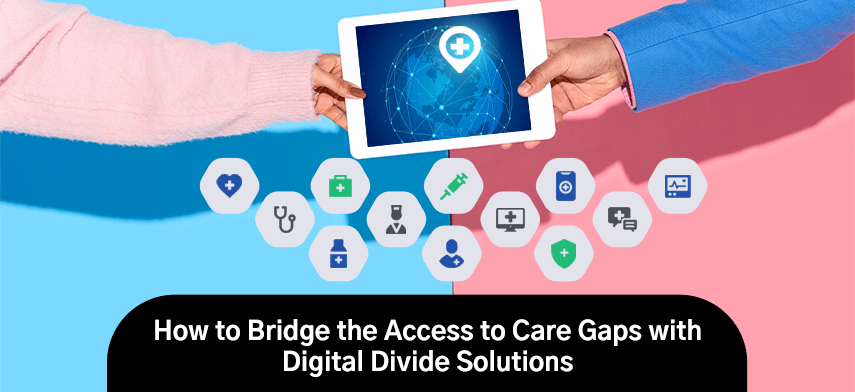Introduction: The digital divide poses a significant barrier in the fast expanding landscape of the software business, generating a technology access gap that impedes advancement and innovation. As we traverse the digital age, it is critical to investigate the issues surrounding this separation and, more significantly, to discover effective ways to bridge the gap.
Understanding the Digital Divide
The digital divide refers to the gap between those who have access to modern information and communication technology (ICT) and those who do not. In the software industry, this divide manifests in various ways, affecting both individuals and communities. One primary challenge is unequal access to education and resources, which can limit opportunities for aspiring software professionals.
Challenges Faced by the Software Industry
Limited Access to Education:
The digital divide often begins with disparities in educational opportunities. Many individuals, especially in underserved communities, lack access to quality education in science, technology, engineering, and mathematics (STEM) fields, hindering their ability to pursue careers in the software industry.
Inadequate Infrastructure:
Unequal distribution of technological infrastructure is another significant challenge. While urban areas may boast high-speed internet and advanced computing facilities, rural regions may struggle with slow connectivity and outdated equipment. This stark contrast in infrastructure can impede the growth of a diverse and inclusive software workforce.
Affordability and Accessibility:
The cost of technology remains a barrier for many individuals. High prices for computers, software licenses, and internet connectivity create financial barriers that prevent aspiring software professionals from fully participating in the industry. Bridging this affordability gap is essential for fostering inclusivity.
Digital Literacy Disparities:
A lack of digital literacy skills exacerbates the digital divide. Some individuals, particularly older populations, may struggle to adapt to rapidly evolving technologies. Addressing this literacy gap is crucial for ensuring that everyone can participate in the software industry.
The Way Forward: Solutions to Bridge the Gap
Promoting Inclusive Education:
To address the digital divide at its roots, there must be a concerted effort to promote inclusive education in STEM fields. Initiatives that provide equal opportunities for education, especially in underserved communities, can help create a diverse talent pool for the software industry.
Investing in Technological Infrastructure:
Governments, private enterprises, and non-profit organizations should collaborate to invest in technological infrastructure in both urban and rural areas. This includes expanding high-speed internet access and providing updated computing facilities to ensure equal opportunities for all.
Affordable Technology Initiatives:
Introducing initiatives that make technology more affordable, such as subsidized computer programs or free software licenses for educational purposes, can significantly reduce financial barriers. This will empower individuals to develop their skills and participate in the software industry.
Digital Literacy Programs:
Implementing digital literacy programs for individuals of all ages can bridge the gap in knowledge and skills. These programs should be designed to be accessible and tailored to diverse learning styles, ensuring that everyone has the opportunity to become proficient in using technology.
Conclusion
Addressing the challenges of the digital divide in the software industry requires a multi-faceted approach that tackles issues related to education, infrastructure, affordability, and digital literacy. By implementing inclusive policies and initiatives, we can bridge the technology access gap and create a more equitable and vibrant software industry that benefits from the talents of a diverse workforce. As we move forward, it is imperative that all stakeholders collaborate to build a future where technology is a tool for empowerment rather than a barrier to opportunity.
What is the digital divide in the context of the software industry?
Answer: The digital divide in the software industry refers to the gap between those who have access to modern information and communication technology (ICT) and those who do not. It encompasses challenges such as unequal access to education, inadequate infrastructure, affordability issues, and digital literacy disparities that hinder equal participation in the software sector.
How does the lack of access to education contribute to the digital divide in the software industry?
Answer: Limited access to quality education, particularly in science, technology, engineering, and mathematics (STEM) fields, creates a significant barrier for individuals aspiring to enter the software industry. The absence of inclusive educational opportunities contributes to a shortage of skilled professionals and perpetuates the digital divide.
What role does technological infrastructure play in the challenges faced by the software industry?
Answer: Unequal distribution of technological infrastructure, including issues like slow internet connectivity and outdated computing facilities, poses a challenge to the growth of a diverse and inclusive software workforce. Disparities in infrastructure between urban and rural areas can hinder equal participation in the industry.
How can affordable technology initiatives help bridge the digital divide in the software industry?
Answer: Affordable technology initiatives, such as subsidized computer programs or free software licenses for educational purposes, can significantly reduce financial barriers. By making technology more accessible, these initiatives empower individuals to develop their skills and contribute to a more inclusive software industry.
What are the key solutions to bridge the digital divide in the software industry?
Answer: Promoting inclusive education in STEM fields, investing in technological infrastructure in both urban and rural areas, introducing affordable technology initiatives, and implementing digital literacy programs are key solutions to bridge the digital divide. These measures aim to create equal opportunities for individuals of all backgrounds to participate in the software industry.


